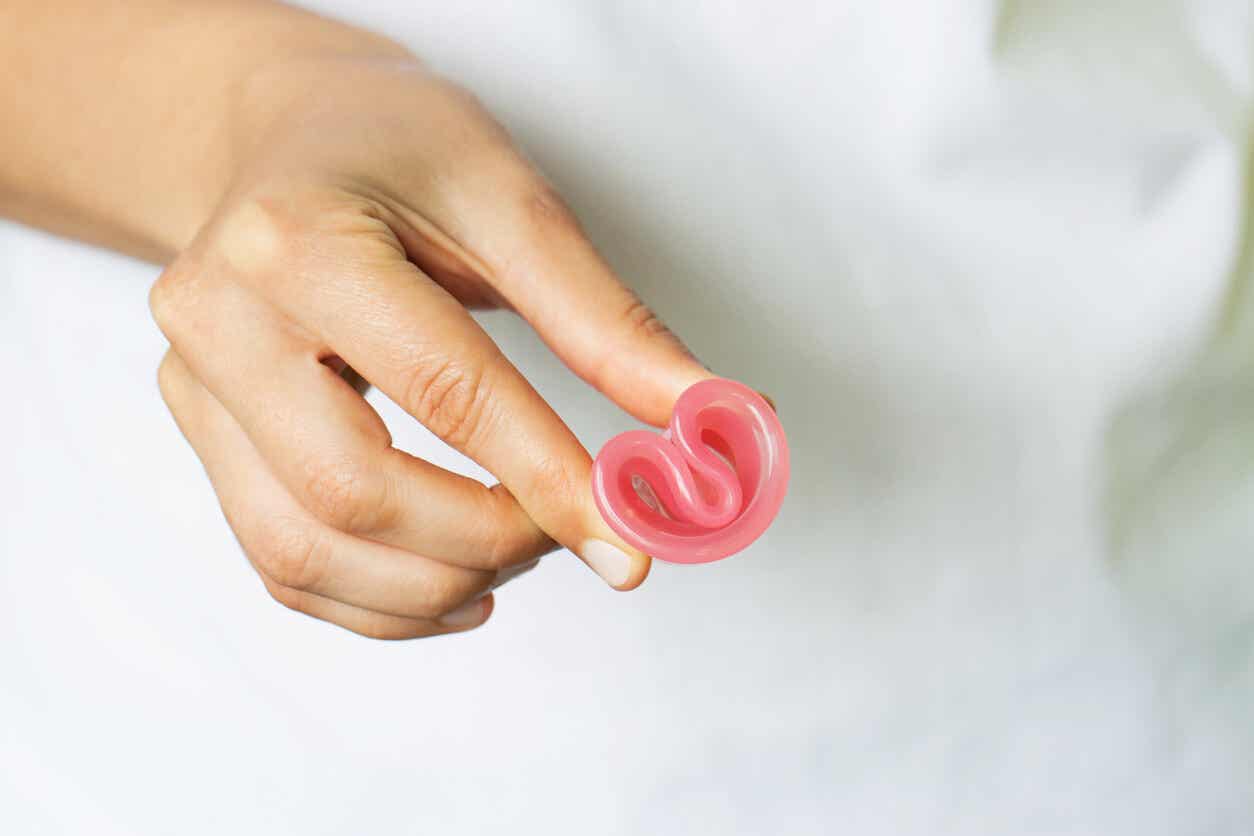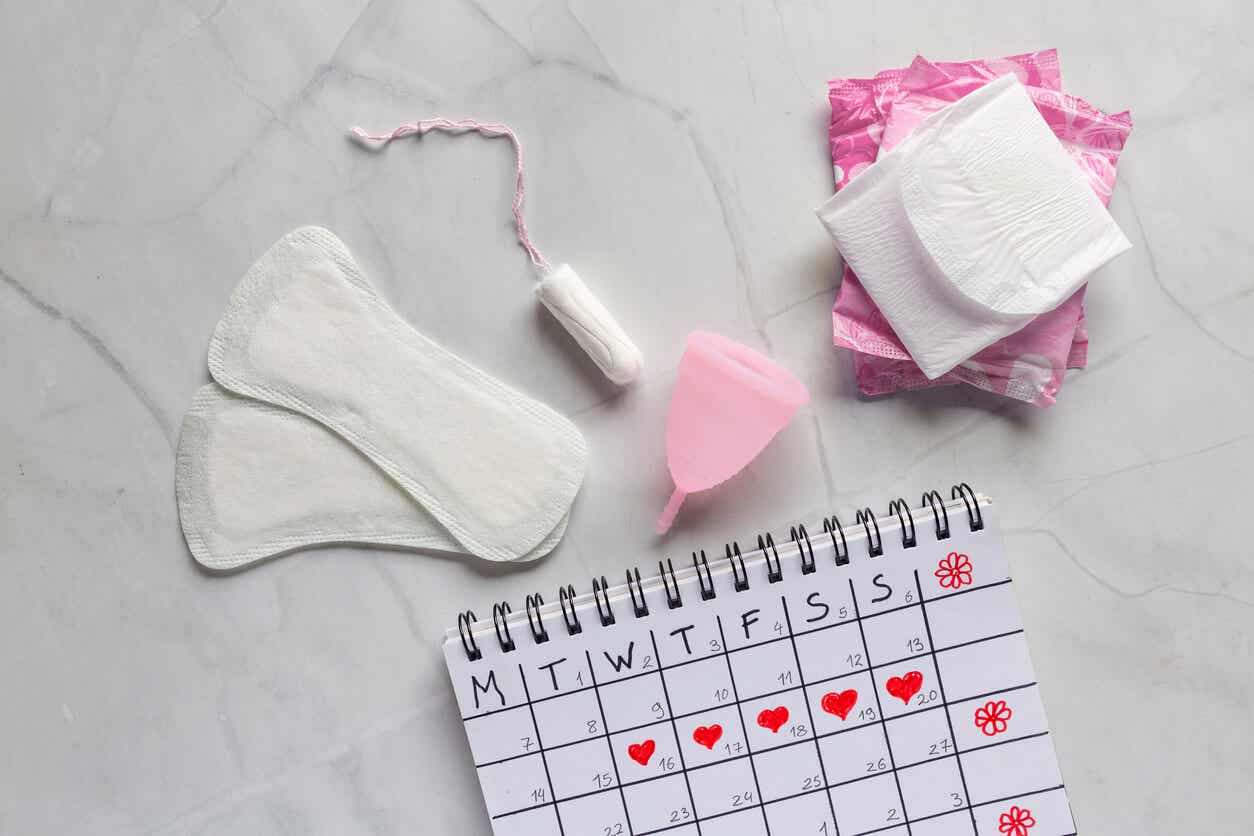Menstrual Cups for Teenagers: What You Need to Know


Written and verified by the nurse Leidy Mora Molina
Menstrual cups have become increasingly popular among women. Both because of their long-term advantages and because they’re hygienic and safe. Many teenage girls have already tried them, but what should you know about using them?
In this article, we’ll tell you all about this type of personal hygiene element so you know how to choose the most appropriate option. Keep reading!
What is a menstrual cup?
The menstrual cup is a cup-shaped container, which is inserted into the vagina during the menstrual period to collect blood flow. In this way, it relaces avoids the use of sanitary pads and tampons.
As it’s made of reusable material, its use is unlimited. It’s usually made of medical silicone, which is soft, flexible, and resistant to bacteria. However, there are other alternatives with different manufacturing components.
How to choose menstrual cups for teenagers
As with adult women, teenagers can use menstrual cups without any problem. The most important thing when choosing a menstrual cup is that you feel comfortable with it.
There are several brands, models, and sizes on the market, from small to large. This size is determined by the height of the cup and its capacity, that is, the amount of liquid it can collect. They usually range from 12 to 50 milliliters.
Another important aspect is the flexibility of its walls, which is closely related to the material from which it is made. The rigidity of the cup must be hard enough to contain the flow, without causing discomfort or pain when it’s in place.
It’s best to opt for a cup with a short height and flexible walls to start with. This way, it’ll be easier to become familiar with insertion, replacement, and the sensation that its use produces.
Before purchasing one, it’s important that you ask for advice from a family member, your gynecologist, or the sellers of these items.
How to use the menstrual cup?
After your first menstruation, it’s essential that you talk to your mother or a woman in the family who can explain what’s happening with your body. In addition, you can get rid of any doubts and learn about feminine hygiene habits.
In the case you choose to try a menstrual cup, it’s important to know everything about them, mainly, the advantages of its use. You should know that it’s a totally safe hygiene element for your health and that it shouldn’t cause any inconvenience or discomfort.
It’s also important that you learn all the steps for a correct placement. You should know that, at first, it may be a little uncomfortable. However, with practice, everything will be easier than with tampons or pads.

Here’s a step-by-step guide to learn how to use a menstrual cup:
- You must sterilize the cup after purchasing it by immersing it in boiling water for 3 minutes.
- Wash your hands with soap and water before and after inserting it.
- Try to relax when inserting the cup to make it easier to enter.
- Adopt the most comfortable position to insert it, either by lifting one leg or by placing it on a stable surface.
- Fold the cup in the way that’s most comfortable for you and place it inside the vagina. Once there, you should no longer feel any discomfort. If you do, try a smaller size.
- Remove it after 4 hours to empty it, clean it, and put it back in. With repeated use, you can use the cup for up to 12 hours without leaking, but this will depend on the individual woman.
- When your period is over, be sure to wash and sterilize it properly.
What are the advantages of using menstrual cups?
The menstrual cup is a safe method with many advantages for your hygiene and health. Let’s take a look at some of the benefits of this menstrual device:
It avoids infections and is hypoallergenic
It’s made of medical silicone, a material that prevents the growth of germs, doesn’t dry out the vaginal walls, and is hypoallergenic. Therefore, it doesn’t irritate, doesn’t cause allergies, and doesn’t interfere with the pH of the vagina.
Its correct use favors the prevention of bacterial vaginosis, which can occur during your period.
Menstrual cups are environmentally friendly
The menstrual cup is reusable and, depending on the material, it can last between 10 to 15 years. For this reason, it’s considered an environmentally friendly alternative for feminine hygiene.
It’s hygienic
Although at first, contact with blood may produce unpleasant sensations, the truth is that the menstrual cup maintains intimate hygiene. In addition to collecting the blood, it leaves no odor, no debris, and no chemicals inside your vagina.
The menstrual cup provides comfort
Once you get used to it, it’s much more comfortable than a sanitary napkin or tampon. Especially if you practice activities such as dancing or swimming. Plus, it offers up to 12 hours of protection.
It helps your economy
Although it’s more expensive to purchase than the other alternatives, it’s a one-time expense. For this reason, in the long run, it ends up being the most economical option.
It promotes self-knowledge
By being in contact with your intimate area, you can better understand the changes in your body, such as the menstrual cycle and its characteristics.

According to an article published by The Lancet, which analyzed the experiences of more than 3,000 women and girls around the world, researchers concluded that the use of the menstrual cup is safe and effective.
Remember that it’s up to you to choose!
Despite the many advantages of its use, it’s important to consider the fact that you may have difficulty adapting to it or even feel afraid to use it.
For this reason, it’s important to respect your decision, whether you’re for or against its use. Some women will want to use it from their first period, while others may want to wait a little longer.
The changes in your body and mind are very intense at this stage of your life, so you should look for what makes you feel good. Even on those days.
Menstrual cups have become increasingly popular among women. Both because of their long-term advantages and because they’re hygienic and safe. Many teenage girls have already tried them, but what should you know about using them?
In this article, we’ll tell you all about this type of personal hygiene element so you know how to choose the most appropriate option. Keep reading!
What is a menstrual cup?
The menstrual cup is a cup-shaped container, which is inserted into the vagina during the menstrual period to collect blood flow. In this way, it relaces avoids the use of sanitary pads and tampons.
As it’s made of reusable material, its use is unlimited. It’s usually made of medical silicone, which is soft, flexible, and resistant to bacteria. However, there are other alternatives with different manufacturing components.
How to choose menstrual cups for teenagers
As with adult women, teenagers can use menstrual cups without any problem. The most important thing when choosing a menstrual cup is that you feel comfortable with it.
There are several brands, models, and sizes on the market, from small to large. This size is determined by the height of the cup and its capacity, that is, the amount of liquid it can collect. They usually range from 12 to 50 milliliters.
Another important aspect is the flexibility of its walls, which is closely related to the material from which it is made. The rigidity of the cup must be hard enough to contain the flow, without causing discomfort or pain when it’s in place.
It’s best to opt for a cup with a short height and flexible walls to start with. This way, it’ll be easier to become familiar with insertion, replacement, and the sensation that its use produces.
Before purchasing one, it’s important that you ask for advice from a family member, your gynecologist, or the sellers of these items.
How to use the menstrual cup?
After your first menstruation, it’s essential that you talk to your mother or a woman in the family who can explain what’s happening with your body. In addition, you can get rid of any doubts and learn about feminine hygiene habits.
In the case you choose to try a menstrual cup, it’s important to know everything about them, mainly, the advantages of its use. You should know that it’s a totally safe hygiene element for your health and that it shouldn’t cause any inconvenience or discomfort.
It’s also important that you learn all the steps for a correct placement. You should know that, at first, it may be a little uncomfortable. However, with practice, everything will be easier than with tampons or pads.

Here’s a step-by-step guide to learn how to use a menstrual cup:
- You must sterilize the cup after purchasing it by immersing it in boiling water for 3 minutes.
- Wash your hands with soap and water before and after inserting it.
- Try to relax when inserting the cup to make it easier to enter.
- Adopt the most comfortable position to insert it, either by lifting one leg or by placing it on a stable surface.
- Fold the cup in the way that’s most comfortable for you and place it inside the vagina. Once there, you should no longer feel any discomfort. If you do, try a smaller size.
- Remove it after 4 hours to empty it, clean it, and put it back in. With repeated use, you can use the cup for up to 12 hours without leaking, but this will depend on the individual woman.
- When your period is over, be sure to wash and sterilize it properly.
What are the advantages of using menstrual cups?
The menstrual cup is a safe method with many advantages for your hygiene and health. Let’s take a look at some of the benefits of this menstrual device:
It avoids infections and is hypoallergenic
It’s made of medical silicone, a material that prevents the growth of germs, doesn’t dry out the vaginal walls, and is hypoallergenic. Therefore, it doesn’t irritate, doesn’t cause allergies, and doesn’t interfere with the pH of the vagina.
Its correct use favors the prevention of bacterial vaginosis, which can occur during your period.
Menstrual cups are environmentally friendly
The menstrual cup is reusable and, depending on the material, it can last between 10 to 15 years. For this reason, it’s considered an environmentally friendly alternative for feminine hygiene.
It’s hygienic
Although at first, contact with blood may produce unpleasant sensations, the truth is that the menstrual cup maintains intimate hygiene. In addition to collecting the blood, it leaves no odor, no debris, and no chemicals inside your vagina.
The menstrual cup provides comfort
Once you get used to it, it’s much more comfortable than a sanitary napkin or tampon. Especially if you practice activities such as dancing or swimming. Plus, it offers up to 12 hours of protection.
It helps your economy
Although it’s more expensive to purchase than the other alternatives, it’s a one-time expense. For this reason, in the long run, it ends up being the most economical option.
It promotes self-knowledge
By being in contact with your intimate area, you can better understand the changes in your body, such as the menstrual cycle and its characteristics.

According to an article published by The Lancet, which analyzed the experiences of more than 3,000 women and girls around the world, researchers concluded that the use of the menstrual cup is safe and effective.
Remember that it’s up to you to choose!
Despite the many advantages of its use, it’s important to consider the fact that you may have difficulty adapting to it or even feel afraid to use it.
For this reason, it’s important to respect your decision, whether you’re for or against its use. Some women will want to use it from their first period, while others may want to wait a little longer.
The changes in your body and mind are very intense at this stage of your life, so you should look for what makes you feel good. Even on those days.
All cited sources were thoroughly reviewed by our team to ensure their quality, reliability, currency, and validity. The bibliography of this article was considered reliable and of academic or scientific accuracy.
- Arenas, C. (2020). Aceptabilidad y seguridad de la Copa Menstrual: Revisión sistemática de la literatura. Revista Colombiana de Obstetricia y Ginecología vol. 71, núm. 2, 2020.
- Beksinska M. (2015). Acceptability and performance of the menstrual cup in South Africa: a randomized crossover trial comparing the menstrual cup to tampons or sanitary pads. Recuperado de: https://pubmed.ncbi.nlm.nih.gov/25682816/
- Juma J (2017). Examining the safety of menstrual cups among rural primary school girls in western Kenya: observational studies nested in a randomised controlled feasibility study. Recuperado de: https://bmjopen.bmj.com/content/7/4/e015429
- Prado, M (2020). La copa menstrual, una alternativa de higiene femenina. Revisión de la literatura. Revista Chilena de Obstetricia y Ginecología 2020; 85(1): 99 – 109.
- UNICEF (2019). Guide to menstrual hygiene materials. Recuperado de: https://www.unicef.org/media/91346/file/UNICEF-Guide-menstrual-hygiene-materials-2019.pdf
This text is provided for informational purposes only and does not replace consultation with a professional. If in doubt, consult your specialist.








